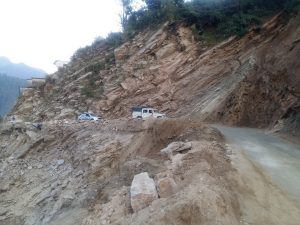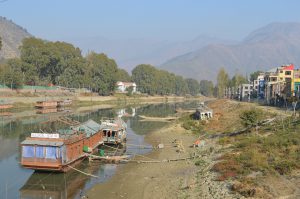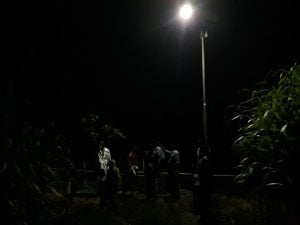We don’t know the air quality in Lahore. There are no air quality meters that measure the Environmental Quality Standards for ambient air. It would take several meters, taking readings 24/7 that could give you some idea of what the ambient air quality in just Lahore is. It is not enough to run a meter out for 24 hours and then “report” what the air quality in the whole city it. The responsibility of the EPA and Government of Punjab is to ensure there enough meters in every urban District of Punjab that can accurately measure and report ambient air quality. Accurate reporting gives the Government the date to warn citizens when air quality is unhealthy. Such information will lead to public awareness, which can help change behaviour and protect against further health issues.

That said, the 2014 World Bank report on air quality in Pakistan – which relied exclusively on secondary data in (articles and studies conducted in the past) the absence of primary air quality data – found the air quality in Lahore to be between 4-14 times WHO limits (air quality gets worse in the winter). They also found that the air pollution is Lahore is caused by road dust, construction dust, vehicle emissions and industrial emissions. This is important as air quality meters not just tell us whether the pollution is bad but also the composition of the air pollution. It won’t do to shut down industry when its construction dust that’s causing the problem. Or to blame the Orange Line construction when in fact it is the rickshaws. Unless we have accurate air quality data, we can’t begin to decipher the problem in Lahore, let alone Punjab. We can’t have a nuanced response or policy unless we have the meters.
Also see: Why Lahore floods, and how to stop it
The Government of Punjab has spent the last year acquiring some meters for the EPA, Punjab. I had a meeting with the Secretary a few days ago. I saw a whole bunch of the meters, in their boxes, unpacked and under the stairs at the EPD office. Apparently some of them are operational but the EPA hasn’t released any data.
Now, across the border, there is enormous air pollution too. Who knows what it is caused by (same problem as here) but last year we know that unprecedented crop burning and westerly winds brought the clouds of smoke to Pakistan as far as Kallar Kahar. There is crop burning this year in India too, despite repeated bans and prohibitions. The Indian Supreme Court has banned fire crackers for Diwali on the grounds they add to the smog pollution (it also pioneering the phrase “Green Diwali”). I checked the NASA satellite website that shows that there is still large amounts of crop burning this year (in Pakistan too), but there are easterly winds. I’m not an expert, and unless there are air quality meters frankly nobody is, so I can’t say if crop burning will add to the smog this year. I do know that the slight drop in temperatures does always raise pollution levels (cooler air compresses the air molecules together, as well the PM 2.5 and other pollutants). That’s why cities across North India are reporting deteriorating air quality.
But even without the Indians burning crops, the air quality in Lahore and Punjab is only going to get worse. This is because there is absolutely nothing being done about tackling air quality. Some persons may say the Government of Punjab’s initiatives of the Bus Rapid Transport and Orange Line are signs of its commitment to public transport. But improving air quality is much, much more than just getting cars off the roads (remember, automobile emissions are just one of the several types of pollution in our air). It’s about setting a vision of what air quality should be and then a political commitment to realize that vision. If Lahore wanted clean air, it would have to take action against industry, automobile drivers and other polluters. It would need to have much more robust public transport, it would have to change the way it designs cities, it would have to press industry to replace old and worn out engines, turbines and machines. It would have to provide incentives to people to buy hybrid of electric cars (over 200,000 electric cars were sold in China this year alone, and the country plans to phase out gas-guzzlers by 2035!!) and for industry to import or make new, cleaner production technologies. Do you see any of that happening? Of course not! And so don’t take the EPA/EPD’s response they’ve acquired the meters as any indication of steps forward of a successful initiative. It’s merely a drop in a large ocean.
Cleaner air is not an easy thing. It requires not just vision and political support. You’ll appreciate that unless all of the things I’ve listed above are not being done, air quality in Lahore (just Lahore, nowhere else) will not improve. Now imagine the money it would take to buy the monitors, the new machines, the cars; the investments in public transport. Air quality improvement comes with a hefty price tag. And I’m afraid the Government of Punjab does not have the resources (even if it had the vision and will) to finance an air quality transition.
What this means is that the private sector must be included in any air quality improvement plan. Private finance from banks and industry will have to be leveraged to implement an air quality improvement. This can be done by raising Green Funds, by establishing green loans, bonds and equities (as has been done in China, for example, and many places elsewhere) and by giving green grants, concessions and tax breaks.
Air quality is one of the biggest killers in the world. It’s one of the biggest killers in Pakistan too. Twelve years ago, the World Bank Environment Assessment report for Pakistan estimated air quality to contribute to over 20,000 cases of premature mortality a year (things have only gotten worse). So of course air quality is not going to be an easy problem to tackle. It’s a vast and complicated challenge with a vast and complicated policy response. I simply don’t see the challenge being taken seriously here, let alone anything worthwhile done to deal with it. This is despite the clear evidence of this air quality emergency. And that’s why it is only going to get worse.
I’m reminded of the parable of the French Frog: That when the French cook frogs, they don’t throw them into boiling water (they’ll hop out). Instead, they put the frogs into a kettle of fresh water and turn the heat on. By the time the frogs realize what’s happening, it’s too late. Living in Lahore and breathing its air, I feel like one of those frogs. But when I do, I have to remind myself the parable is not true. Frogs jump out of the water when it gets uncomfortable, naturally. This is good news, because it means awareness is key to change.
![<p>A long way to go for clean air in Lahore [image by: Heinrich Boll Stiftung / Flickr]</p>](https://dialogue.earth/content/uploads/2017/10/Lahore-sign.jpg)







